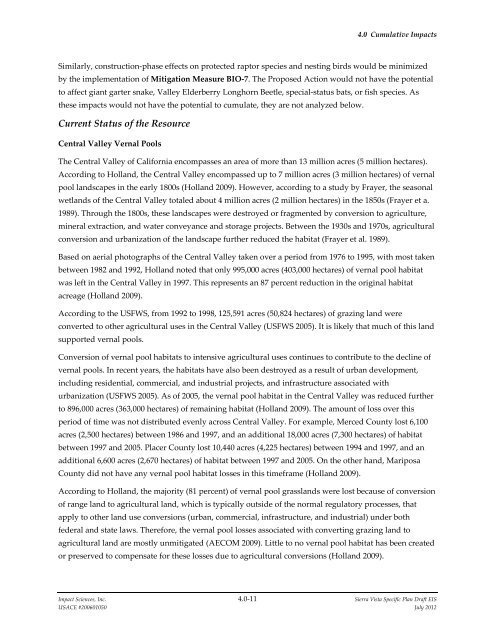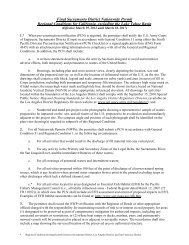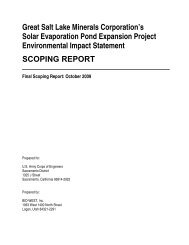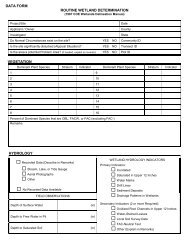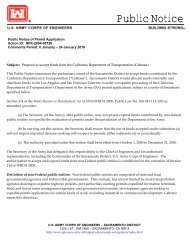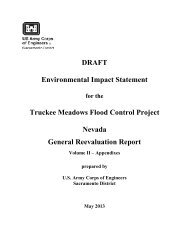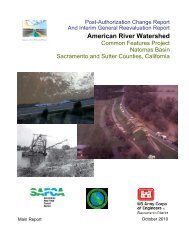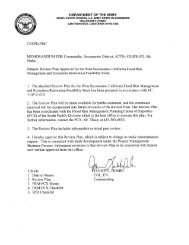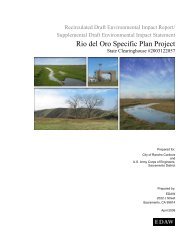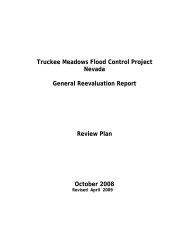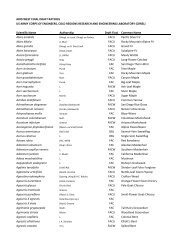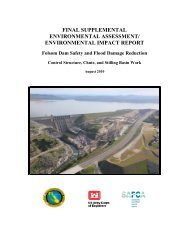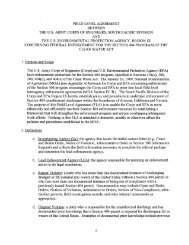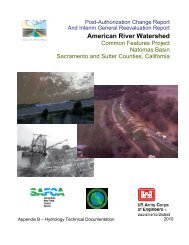4.0 CUMULATIVE IMPACTS - Sacramento District - U.S. Army
4.0 CUMULATIVE IMPACTS - Sacramento District - U.S. Army
4.0 CUMULATIVE IMPACTS - Sacramento District - U.S. Army
You also want an ePaper? Increase the reach of your titles
YUMPU automatically turns print PDFs into web optimized ePapers that Google loves.
<strong>4.0</strong> Cumulative Impacts<br />
Similarly, construction-phase effects on protected raptor species and nesting birds would be minimized<br />
by the implementation of Mitigation Measure BIO-7. The Proposed Action would not have the potential<br />
to affect giant garter snake, Valley Elderberry Longhorn Beetle, special-status bats, or fish species. As<br />
these impacts would not have the potential to cumulate, they are not analyzed below.<br />
Current Status of the Resource<br />
Central Valley Vernal Pools<br />
The Central Valley of California encompasses an area of more than 13 million acres (5 million hectares).<br />
According to Holland, the Central Valley encompassed up to 7 million acres (3 million hectares) of vernal<br />
pool landscapes in the early 1800s (Holland 2009). However, according to a study by Frayer, the seasonal<br />
wetlands of the Central Valley totaled about 4 million acres (2 million hectares) in the 1850s (Frayer et a.<br />
1989). Through the 1800s, these landscapes were destroyed or fragmented by conversion to agriculture,<br />
mineral extraction, and water conveyance and storage projects. Between the 1930s and 1970s, agricultural<br />
conversion and urbanization of the landscape further reduced the habitat (Frayer et al. 1989).<br />
Based on aerial photographs of the Central Valley taken over a period from 1976 to 1995, with most taken<br />
between 1982 and 1992, Holland noted that only 995,000 acres (403,000 hectares) of vernal pool habitat<br />
was left in the Central Valley in 1997. This represents an 87 percent reduction in the original habitat<br />
acreage (Holland 2009).<br />
According to the USFWS, from 1992 to 1998, 125,591 acres (50,824 hectares) of grazing land were<br />
converted to other agricultural uses in the Central Valley (USFWS 2005). It is likely that much of this land<br />
supported vernal pools.<br />
Conversion of vernal pool habitats to intensive agricultural uses continues to contribute to the decline of<br />
vernal pools. In recent years, the habitats have also been destroyed as a result of urban development,<br />
including residential, commercial, and industrial projects, and infrastructure associated with<br />
urbanization (USFWS 2005). As of 2005, the vernal pool habitat in the Central Valley was reduced further<br />
to 896,000 acres (363,000 hectares) of remaining habitat (Holland 2009). The amount of loss over this<br />
period of time was not distributed evenly across Central Valley. For example, Merced County lost 6,100<br />
acres (2,500 hectares) between 1986 and 1997, and an additional 18,000 acres (7,300 hectares) of habitat<br />
between 1997 and 2005. Placer County lost 10,440 acres (4,225 hectares) between 1994 and 1997, and an<br />
additional 6,600 acres (2,670 hectares) of habitat between 1997 and 2005. On the other hand, Mariposa<br />
County did not have any vernal pool habitat losses in this timeframe (Holland 2009).<br />
According to Holland, the majority (81 percent) of vernal pool grasslands were lost because of conversion<br />
of range land to agricultural land, which is typically outside of the normal regulatory processes, that<br />
apply to other land use conversions (urban, commercial, infrastructure, and industrial) under both<br />
federal and state laws. Therefore, the vernal pool losses associated with converting grazing land to<br />
agricultural land are mostly unmitigated (AECOM 2009). Little to no vernal pool habitat has been created<br />
or preserved to compensate for these losses due to agricultural conversions (Holland 2009).<br />
Impact Sciences, Inc. <strong>4.0</strong>-11 Sierra Vista Specific Plan Draft EIS<br />
USACE #200601050 July 2012


